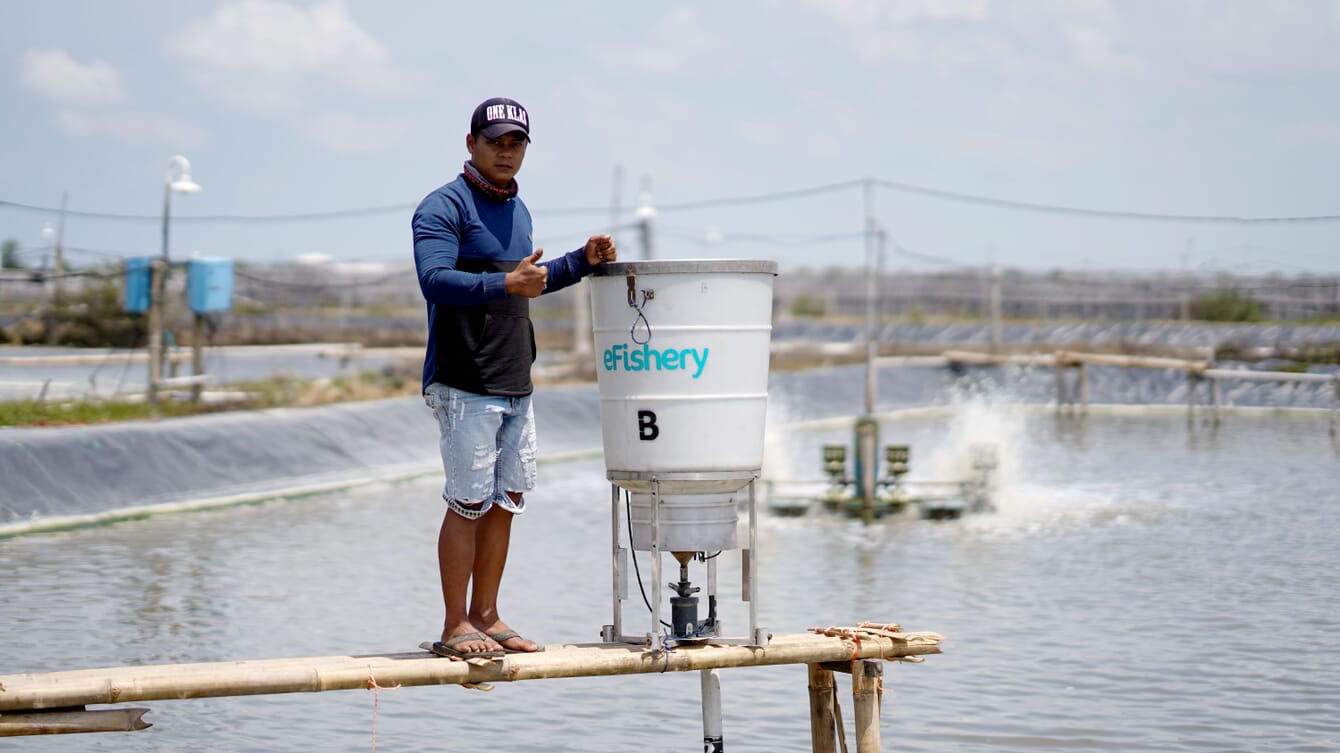
eFishery’s $200 million round in 2023 made it the first startup in the global aquaculture industry to reach a valuation of over $1 billion © eFishery
In 2023, the hurdles for venture capital deployment were raised and fewer funding rounds occurred, due to a challenging macro-economic environment, characterised by rising interest rates and a realignment of valuation expectations. The cautious private investment sentiment was reflected by the slow adoption of innovative technologies in aquaculture.
Over the past 12 months, aquablurb recorded $2.2 billion in publicly announced aquaculture and alternative seafood funding, across 87 rounds, with venture funding accounting for $808 million of this figure, across 56 rounds. As a key contributor to global food security, with 87.5 million tonnes produced in 2020 (FAO, 2022), the pace of aquaculture innovation is expected to accelerate to reach 106 million tonnes of production by 2030, in order to help to fulfil the protein demands of 9.7 billion people.
This is the inaugural instalment of our aquaculture deal flow analysis series. Going forward, The Fish Site and aquablurb aim to provide an accurate annual analysis of year-on-year aquaculture deal flows and share insights into trends, opportunities and market gaps. To help to illustrate the trend we've even added interactive data story points, which our readers can navigate using the buttons on each chart.
Interested in regular updates on aquaculture investments? Sign up to aquablurb here!
Aquaculture deals in 2023
Of the 87 deals recorded, venture capital and private equity firms (grouped as venture funding) were the most active funding entities and invested $808 million across 56 deals. Corporates invested $1.2 billion across 18 deals, largely through strategic investments. Together, corporates and venture funding distributed 92.8 percent of the total capital invested in aquaculture and alternative seafood companies in 2023. The distribution of capital and deal counts across venture and corporates reflects a healthy market where innovation and consolidation exist in parallel to drive creativity and efficiency from idea phase to commercial implementation.
February was the busiest month for venture deal announcements in 2023, although the highest level of capital deployed happened in July, following the announcement of Series D rounds by eFishery and FreshtoHome.
The following analysis focuses on deals led by venture funding only:
By series
Seed and Series A rounds were the most active, with 16 and 15 deals respectively. These numbers are an underestimation and do not include the 12 early stage deals without series specification. The Series D rounds raised by eFishery in Indonesia ($200 million) and FreshtoHome in India ($104 million) dominated the total capital raised. Series A rounds secured $129 million (15.9 percent) across 15 deals and Series B rounds secured $123 million (15.2 percent) across three deals.
eFishery and FreshtoHome both offer software e-commerce or marketplace solutions to enable regional vertical integration. Platform technology is so appealing as it allows for rapid scaling with fewer engineering hurdles and long sale cycles experienced more frequently by hardware solutions. eFishery provides better data-driven insights into farm-level productivity, improves access to local and global feed markets at better pricing, improves farmers’ access to financing and thus accelerates the integration of the aquaculture supply chain. Such investments are a venture favourite, generating higher profit margins in shorter turnaround times.
Equally important to platform technology and marketplace investments are R&D and investments into hardware and genetics. Aquaculture relies on quality infrastructure and superior genetics to drive growth. Venture funds must learn to endure long funding cycles and high upfront capex to achieve long-term success in aquaculture. Innovative financing vehicles and a combination of debt and non-dilutive funding may be the key to reducing risk and unlocking necessary developments.
In current markets, the majority of aquaculture innovation occurs during Seed and Series A stages. However, as the market and service/product offering matures, expect to see larger rounds and increased numbers of later stage raises in the coming years.
By segment
In terms of total venture funding raised by segment, the supply chain (11 deals, worth $384 million) came top, followed by alternative seafood (13 deals, worth $131 million) and production systems (five deals, worth $131 million).
Excluding the $304 million raised by eFishery and FreshToHome, the majority of venture funding in the supply chain segment was raised across Series A, B and C rounds. Startups in the supply chain segment are raising later rounds ahead of those in other segments. The majority of the alternative seafood startups are in their early stages, and entering into pre-commercialisation, with most capital allocated towards Seed and Series A and a few in Series B. The majority of capital deployed in production systems comes in the form of convertible debt, to reduce risk. A significant portion of capital invested in production systems did not specify either the type of investment or the series.
By region
In terms of geographical breakdown, Asia-Pacific (APAC) led the way, raising $365 million (45.2 percent), while Europe came second with $225 million (27.87 percent) and North America third with $136 million (16.9 percent). India and Indonesia raised the most venture capital in APAC.
Excluding the eFishery and FreshtoHome rounds, the remaining supply chain deals were similarly distributed across Asia and Africa, with many focusing on offerings that target improving the efficiency of smallholder tilapia or shrimp farmers across a relatively fragmented marketplace.
The majority of alternative seafood funding was raised by North American and European startups, where demand persists from groups of environmentally conscious and less price-sensitive consumers.
All funding allocated to production systems, including RAS and offshore technologies, were deployed in Europe to tap into expertise from the salmon and trout industry or to take advantage of optimal water conditions and tax incentives.
Overall, investors favoured production systems, alternative seafood and nutrition investments in Europe; alternative seafood and blue carbon (Running Tide’s $54 million Series B) investments in North America; supply chain and alternative seafood investment in APAC; supply chain investment in Africa; and alternative seafood, as well as health and genetics, in the Middle East.
Deals of interest
Each of the 87 deals plays an unique and important role in advancing the aquaculture economy. Underlying each deal is the investor’s understanding and prediction of the market. However, here are a couple of deals that really grabbed the attention of key venture investors:
- Arguably the most significant aquaculture startup investment to date, eFishery’s $200 million round made it the first startup in the global aquaculture industry to reach a valuation of over $1 billion. The deal is also significant as it will help to bring access and affordability to small-scale farmers, who account for over 90 percent of the global aquaculture sector’s employment.
- Finnish biotech Enifer’s €11 million Series A round raised in April 2023. To feed the 9.7 billion human population by 2050, the world needs diversified stocks of ingredients to reduce the protein gap as land becomes increasingly scarce. Carsten Krome, general partner of Hatch Blue, believes that Enifer’s Pekilo protein, which is produced from mycelium and industrial waste streams, is one of few ingredients that has the potential to compete against soy in the long-term.
- Vertically integrated tilapia producer Victory Farms - which operates in Kenya and Rwanda - secured $35 million Series B financing in April 2023. The company’s upward trajectory offers hope for those looking to improve food security and generate valuable jobs for locals in sub-Saharan Africa.
Looking forward
In the coming years, startups that improve supply chain efficiency - such as Jala, eFishery and AquaConnect - are likely to remain relevant. The market demands a more integrated approach to overcome inefficiency.
Increased attention is likely to be given to nutrition and feed ingredients, with more investments to accelerate the production of novel ingredients such as mycelium and single cell protein expected, while insect producers will continue to consolidate.
More capital will almost certainly be invested in both offshore aquaculture development and RAS infrastructure, to meet rising demand for seafood, due to the limited availability of new coastal areas that are suitable for aquaculture. Meanwhile, interest in cell cultivated seafood is expected to bounce back following a dip in 2022-2023.
Overall, we expect the pace of innovation to accelerate in the next few years, as a range of technologies - and the companies that are developing them - mature.
For fortnightly investment insights sign up to Linda's aquablurb newsletter here.




